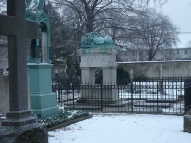

Invalidenfriedhof (4)
Location: Scharnhorststraße 33
Today: Partly destroyed when the Berlin wall was built. There is still a cemetery.
The Invalidenfriedhof is the traditional cemetery of the Prussian Army since 1748. Several World War I commanders were buried here and during the Nazi regime senior officers, such as Reinhard Heydrich, Werner von Fritsch, Werner Mölders, Walter von Reichenau and Rudolf Schmundt found their last resting place here, just like Munitions Minister Fritz Todt. After World War II all Nazi monuments were removed, including the gravestones of Reinhard Heydrich and Fritz Todt. Their remains were not disinterred. The cemetery, that was near the Berlin wall, was closed in 1951. Over a third of the cemetery was destroyed to make way for watch towers, troop barracks, roads and parking lots. In 1990 the cemetery was restored partly.
Adolf Hitler was present at the funeral of some of the people that were buried here, like Heydrich and Mölders. On February 5, 1933 Hitler spoke at the large state funeral of SA-
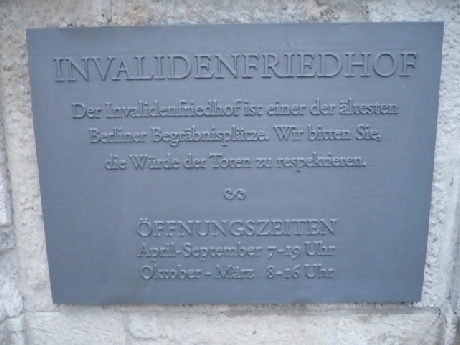
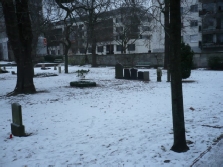
An impression of the cemetery
(picture: the Hitlerpages, 2015)

The new grave marker for Fritz Todt was placed in 2004.
It was removed in 2007.
(picture: wikipedia, 2004)
The sign near the entrance of the cemetery
(picture: the Hitlerpages, 2015)
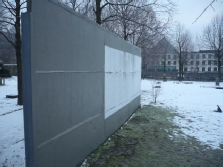
This wall marks the location where the Berlin wall used to be.
(picture: the Hitlerpages, 2015)
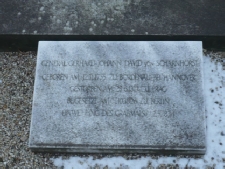
The grave of general Von Scharnhorst.Gerhard Johann David Waitz von Scharnhorst (1755-

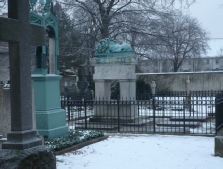
The old grave marker of Fritz Todt and the new one from 2004 were on the right side in the back of this picture, next to the graves and the tree in the centre.
(picture: the Hitlerpages, 2015)
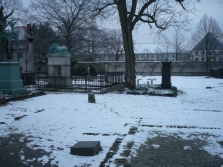

Fritz Todt (1891–1942) was a construction engineer and Reich Minister for Armaments and Ammunition during the Third Reich. He was the leader of Organisation Todt. He died in a plane crash in 1942. His grave that used to be on this location was removed, and later a new marker was placed and taken away again.
(picture: KvdW, the Hitlerpages, 2018)
Schröder’s restored gravestone at the Invaliden Friedhof
Invalidenfriedhof -
Location: Scharnhorststraße 33, exact locastion grave unknown
Today: Restored.
When Adolf Hitler was in Bayreuth in July 1933, he went to Berlin (by plane from München) to attend the burial of the remains of Ludwig von Schröder at the Invalidenfriedhof in Berlin. After that, Hitler went back to Bayreuth.

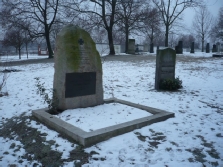
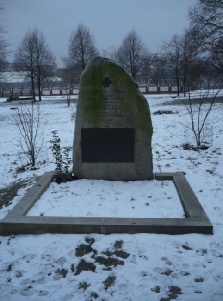
Invalidenfriedhof -
Location: Invalidenfriedhof, Scharnhorstrasse 33, read below for the possible right sections
Today: The stone has been removed, but the grave is still there.
Reinhard Heydrich died on June 4, 1942 in a hospital in Prague as a result of an assassinated attempt by Czech agents. His body was brought to the Reichskanzlei in Berlin. He got a state funeral on June 9, 1942. Hitler held a speech inside the Reichskanzlei. After that Heydrich was brought to the Invalidenfriedhof. Hitler was there when Heydrich was buried. Himmler held a speech at his grave. It could be that the grave is still there. The stone is not longer there. I found different statements about the location of the grave. One source states that the grave is in section A, adjecent to the front entrance. Another source speaks about section C, between the large plots of Oven and Scharnhorst. A third source states that the grave is in section C, inbetween the graves of a certain Anthes and Graf Tauentzien von Wittenberg. This last idea is found on the website ww2gravestone.com. It states: ‘Klaus Pohle from Ottawa, Canada, very interested in war graves, made investigations after the grave of Heydrich and ascertained the right spot with photographs from the burial and the cemetery archives. He visited the cemetery and with his compositions he is sure to have found the right spot of the grave, between the graves of a certain Anthes and Graf Tauentzien von Wittenberg. He visited the cemetery accidental shortly after Heydrich's death date and the same gravestone he found, had a fresh floral tribute and a note in Polish attached to a rose.’
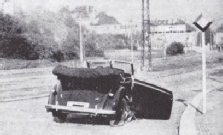

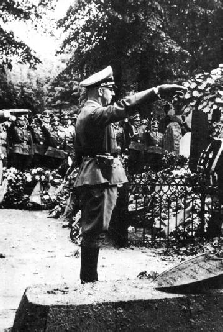
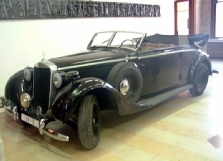
Heydrich’s car after the assassination attack (picture: De Gestapo, 2004)
Hitler speaks at the state funeral of Heydrich in the Reichskanzlei. (picture: De Gestapo, 2004)
Himmler at Heydrich’s funeral
(picture: Hitler's Handlangers, 2004)
Heydrich’s car still exists. It’s at the Military Technical Museum of the Military Historical Institute in Prague.
(picture: wikipedia, FunkMonk, 2005)
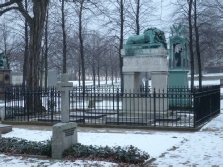
Somewhere on this side of the Scharnhorst memorial (with the statue of the lion) the grave of Heydrich might have been.
(picture: the Hitlerpages, 2015)
The area near the entrance of the Invaliden Friedhof is also mentioned as the area where Heydrich’s grave could have been..
(picture: the Hitlerpages, 2015)
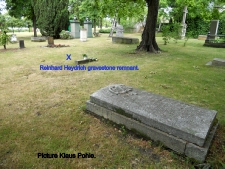
A picture of the alleged grave site according to ww2gravestone.com.
(picture: ww2gravestone.com)
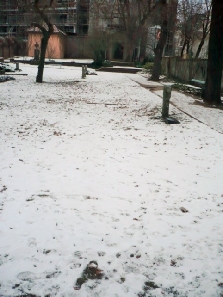
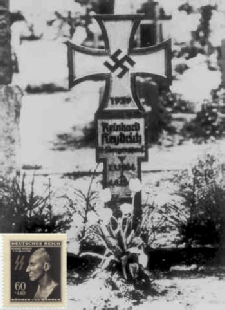
Heydrich’s grave marker
(picture: unknown)

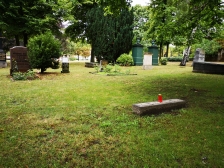

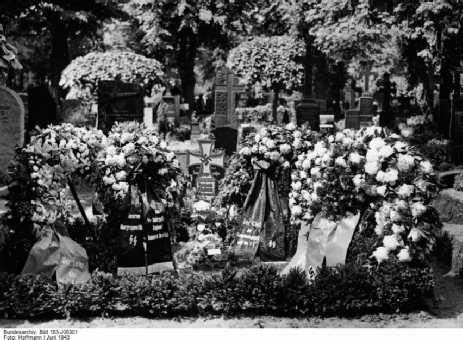

Poststadion (3)
Location: Lehrter Straße 59, near Fritz-
Today: Sportstadion. Baudenkmal since April 30, 1990. Partly destroyed in the war, but rebuilt in 1945.
On May 1, 1936 Hitler spoke to the Hitlerjugend at the Poststadion.
An old picture of the Poststadion (picture: www.stiftung-
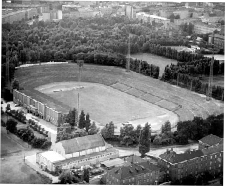

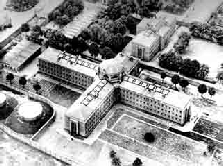

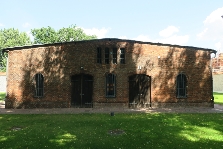
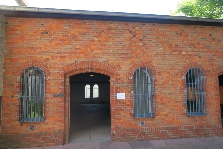
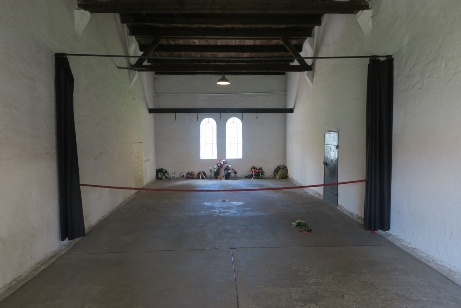
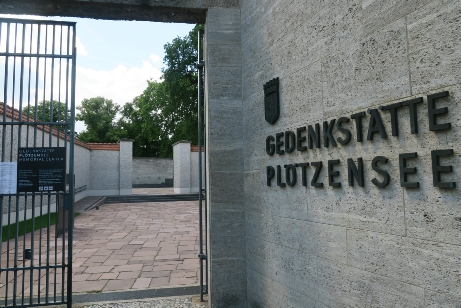



Berlin North
The locations that could be linked to Hitler that are North of Unter den Linden and the Kaiserdamm are on this page and map.
1. Speer Platte
2. Plötzensee Execution Chamber
3. Poststadion
4. Invaliden-
5. Kriegersvereinshaus
6. Theater des Volkes
7. Horst-
8. Nicolaifriedhof
9. NSDAP Gau Berlin
10. Saalbau Friedrichshain
11. Flak Tower Friedrichshain
12. Schultheiss-
13. Flak Tower
14. Clinic Berlin-
15. Wilhelmplatz

Grave of Horst Wessel at the Nicolaifriedhof (8)
Location: St. Nicolaifriedhof: Corner Mollstrasse/Prenzlauer Allee. The grave was found in section 1, row 11, grave 2. To find its former location, follow the instructions that go with the pictures below.
Today: The cemetery was still there and so was the grave in May 2013, when I was there. The gravestone was ruined, but a part of it was still on the same location as it was. Only the name of the father of Horst Wessel, Pfarrer Ludwig Wessel was still partly readable. The surname Wessel had been removed. The original memorial was partly destroyed in 1945 and Wessel's remains were apparently removed. In August 2013 the stone was removed.
On January 14, 1930 the young nazi Horst Wessel was killed by a communist. He died on February 23, 1930. On January 22, 1933 Hitler spoke at the inauguration of the gravestone of Horst Wessel. Wilhelm Ludwig Georg Wessel, the father of Horst Wessel, was the pastor of the Nicolaikirche on the Poststraße (Nicolaiviertel) between 1913 and 1923. Horst Wessel was burried in the same grave as his father. In the year 2000 a group called the Autonomen Totengräber dug into the grave. They said they had taken the skull of Wessel to throw it in the river Spree. The police was not sure about that, because the digging didn’t seem to have gone so deep.
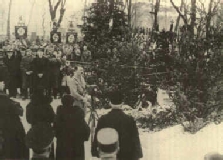
Hitler at the grave of Horst Wessel. Behind him on the picture is the grave with the fence around it.
The remains of the Wessel gravestone with the fence of the other grave next to it. (pictures: the Hitlerpages, 2013)
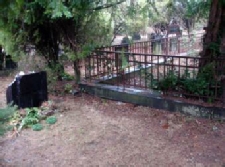
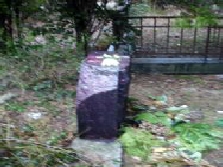
The Wessel grave as it was
The stone looks very dark here, because it was raining on the day the picture was taken. That is also the reason why the name on the stone is hard to read. Looking closely at the picture on the right you can read the words: ‘Pfarrer Ludwig’, the father of Horst Wessel. The pictures also show that people still bring flowers to the grave. (pictures: the Hitlerpages, 2013)
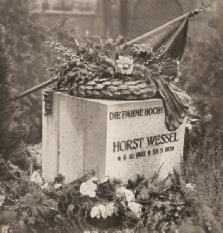
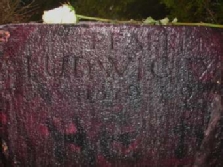
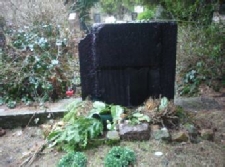
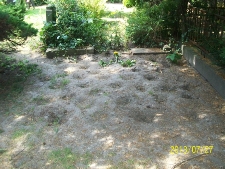
In August 2013, just a few months after the other colored pictures were taken, the gravestone was removed. A helpful source sent a picture of the grave site and informed me about the removal.
(picture: all rights reserved, the Hitlerpages, 2013)
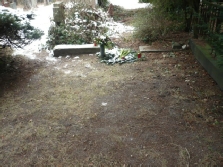
Still some people lay flowers on the grave site.
(picture: the Hitlerpages, 2015)
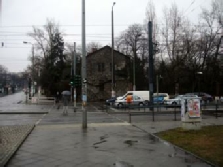
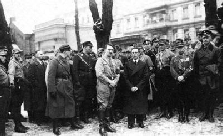
The Horst Wessel remembrance of January 22, 1933. Hitler visites the grave. On the left side behind Hitler are the gravehouses.
(picture: Hitler's Handlangers, 2004)
The location of the grave
Take the entrance to the graveyard on the Prenzlauer Allee, near corner Mollstrasse. Immediately turn left and walk a little uphill, along the Prenzlauer Allee towards three gravehouses that are covered with bulletholes from 1945.
In front of another memorial, next to the three grave houses, is a large tree on the left side of the path. On the right side of the stone path, directly across from the location of the tree, is a path that runs into the bushes, past the grave of the family Praedel. It has a fence around it. Next to it was the gravestone of the Wessel family.
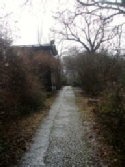

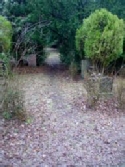
The gravehouses near the Wessel grave today
(pictures: the Hitlerpages, 2013)

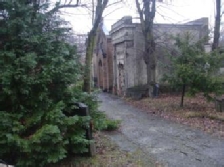
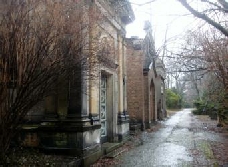
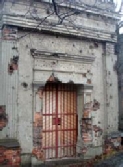
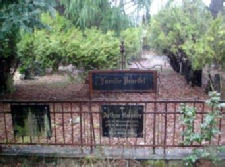
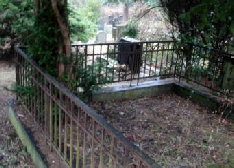
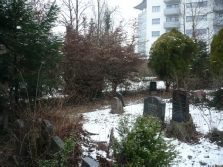

The location where Hitler stood in 1933 and 2015.
(picture: the Hitlerpages, 2015)
Theater des Volkes (Friedrichstadtpalast) (6)
Location: Am Zirkus 1
Today: Bombed but rebuilt. Torn down again in the 1980’s, leaving an open space between surrounding buildings. In the meantime a new building is constructed in the location of the theatre.
On December 17, 1937 Hitler held a speech for the workers of the Autobahn because the 2000th kilometer was reached. On December 15, 1938 the 3000th kilometer was reached, so Hitler held another speech for the Reichsautobahn(RAB) workers.
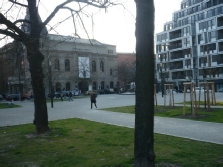
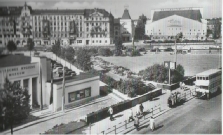
The theatre and the Schiffbauerdamm in 1962. The open space on this side of the river Spree has been filled up with large buidings.
The Bertolt-




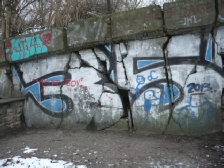
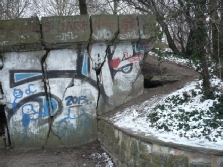

Horst-
Location: Rosa-
Today: The Horst-
After Hitler became Reichskanzler the Bülowplatz in Berlin was renamed Horst-
The Rosa Luxemburg Platz today

The Horst Wessel Platz is now called Rosa Luxemburg Platz.
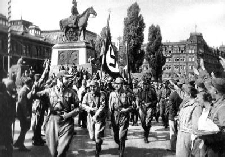
A picture of Horst Wessel in Nürnberg
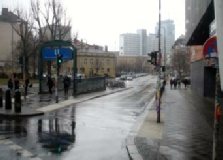



Flak Tower Humbolthain (13)
Location: Volkspark Humbolthain, Brunnenstrasse, Berlin-
Today: Flaktower Humbolthain is partly demolished, but large parts still remain
Hitler had air-
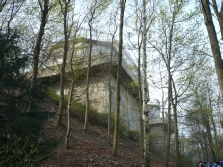
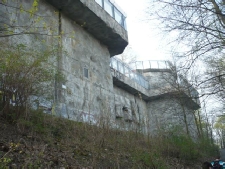

Berlin-
Location: Exact streetname unknown, but the clinic lies in between the Wiltbergstrasse, the Pölnitzweg, the Röbellweg and the Hochbrechtsfelder Allee. Look at Google Earth for an exact placemark. For a picture, look at
Today: The clinic is probably still there.
Some say Hitler's body and the body of Eva Braun were never found. We know that the bodies were burned in the garden of the Reichskanzlei, but what happened to the remains is not clear. Russian sources state that the remains of Hitler, Braun and Goebbels were burried in the yard of the Buch-
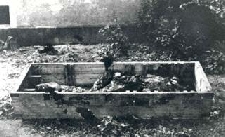

Wilhelmplatz (15)
Location: Wintersteinstraße turning into Richard-
Today: Richard-
On April 19, 1937 Hitler spoke to soldiers of the Wehrmacht on the Wilhelmsplatz. On June 16, 1937 he spoke to 1300 faschistischen Jungführern there.
Two old postcards of the Wilhelmplatz
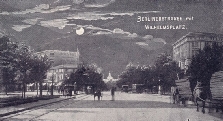
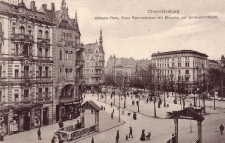
Schultheiss Brewery and other locations were William Patrick Hitler worked (12)
Location: The Schultheiss-
Today: The Schultheiss-
William Patrick Hitler worked in Berlin for a while, for the following companies:
1. Reichskrecht Gesellschaft
2. Opel, Rüsselheim
3. Opel Eduard Winter, Kurfürstendam 207
4. Schultheiss-
House of Helene Bechstein (16)
Location: Kaiserin Augusta Allee 137
Today: The Kaiserin Augusta Allee was partly renamed in 1946. It seems like number 137 doesn’t exist anymnore. The house was probably ruined in the war, but I’m not sure what happened to it.
On June 5, 1922 Adolf Hitler was refused as a guest by the owner of the hotel Exelsior. Edwin and Helene invited him to stay at their house. On January 29, 1933 Adolf Hitler and Karl Freiherr von Hammerstein Equord met at the house of the Bechsteins.
C. Bechstein Piano factory (17)
Location: Johannisstrasse 5-
Today: Bombed and replaced.
The piano factory of the Bechstein family was located in Berlin. Adolf Hitler was a friend of Helene Bechstein, the wife of Edwin Bechstein.
Kunstausstellungsgebäude
Location: Near the Lehrter Bahnhof, Lehrter Strasse
Today: Not longer there. The Lehrter Bahnhof is replaced by the new Hauptbahnhof of Berlin. Exact location of the Kunstausstellungsgebäude unknown.
Adolf Hitler visited the Berliner Kunstausstellung on July 12, 1928.
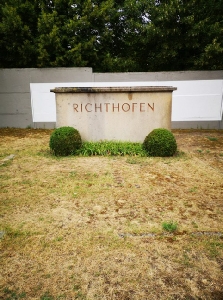


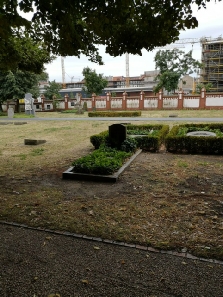

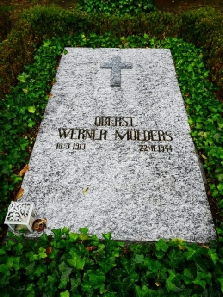

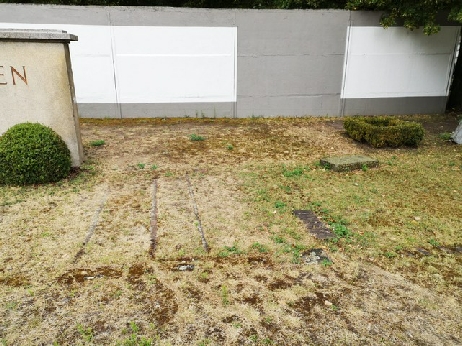

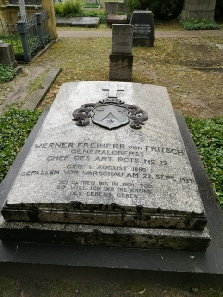

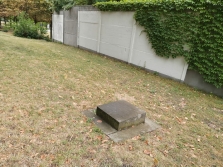
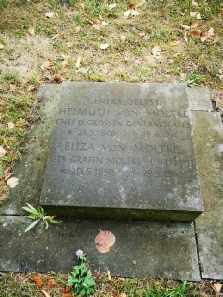
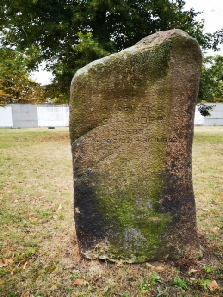
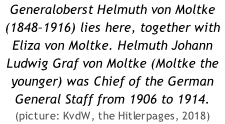

The Invaliden Friedhof

The gravestone of Mölders with behind it the remains of the Berlin Wall.(picture: the Hitlerpages, 2015)

Hitler in front of the Reichsluftfahrtministerium. He was there for the funeral of Werner Mölders.
(picture: copyright unknown)

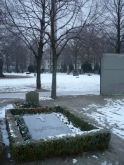
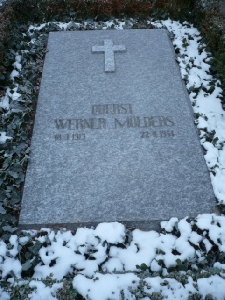

Invalidenfriedhof -
Location: Scharnhorststraße 33
Today: Partly destroyed when the Berlin wall was built. The grave of Mölders is still there.
Werner Mölders was a German Luftwaffe Fighter ace. He died in a planecrash. He received a state funeral. From the Ehrensaal of the Reichsluftfahrtministerium he was brought to the Invalidenfriedhof. He was burried next to Ernst Udet and Manfred von Richthofen (famous pilots of WW1). Hitler attended the funeral.
The gravestone of Mölders
(picture: the Hitlerpages, 2015)
The gravestone of Mölders on the Invalidenfriedhof
(picture: the Hitlerpages, 2015)


